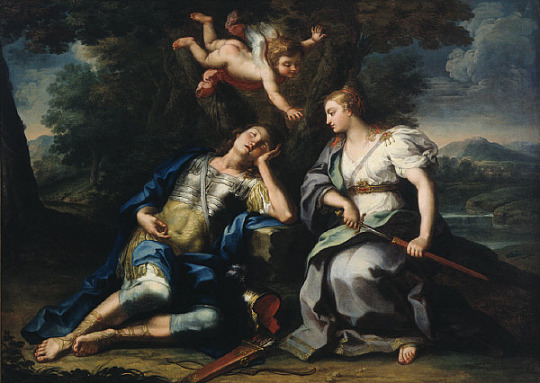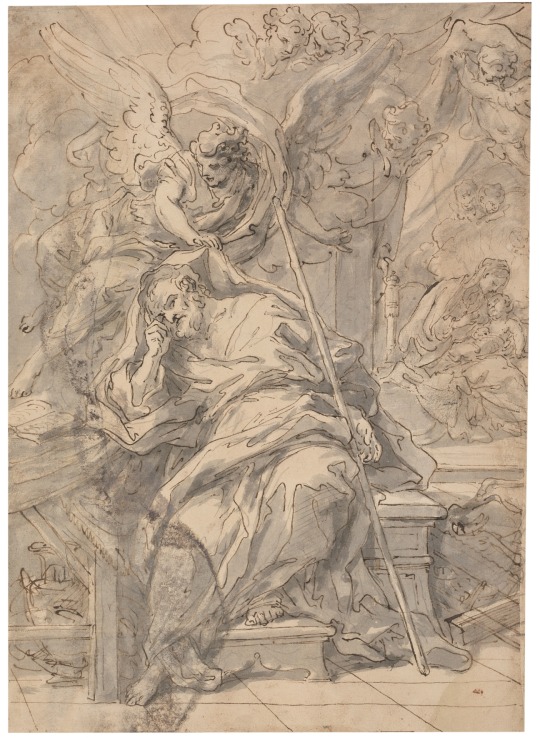#sebastiano conca
Explore tagged Tumblr posts
Photo

Sebastiano Conca (attributed to), Rinaldo and Armida, ca. 1725, oil on canvas, 99,1 x 135,9 cm, Saint Louis Art Museum, St. Louis
Source: Wikimedia Commons
#art#painting#sebastiano conca#oil painting#oil on canvas#baroque#baroque art#baroque painting#Italian baroque#late baroque#18th century#1720s#rinaldo and armida#rinaldo#armida#La Gerusalemme liberata#gerusalemme liberata#Jerusalem Delivered#torquato tasso#italian literature#literary subject
29 notes
·
View notes
Video
youtube
Sebastiano Conca, alcuni lavori a soggetto mitologico
0 notes
Text

Sebastiano Conca, Sueño de San José, XVIII c. x
1 note
·
View note
Text

Sebastiano Conca (Gaeta 1680 - Nápoles 1764)
SANTO DOMINGO RESUCITA A UN ALBAÑIL.
8 notes
·
View notes
Text

Sebastiano Conca
8 notes
·
View notes
Text

CONCA Sebastiano (Gaëte, 1680-1764) La adoración de los magos Óleo sobre tela Alt. 51,1 cm. L.67,5 cm. Colección Charles Schmidt, adquirida en 1874 Inv. 1874-5-53
La obra de Conca durante los primeros años de su estancia en Roma, como muestra este cuadro, afirma una doble influencia. El del barroco, fruto de sus años de formación en Nápoles con Solimena, pero también el de un clasicismo refinado que dominaba el medio artístico romano en torno a Maratta, y que Conca parece haber asimilado sorprendentemente a su llegada a la ciudad.
En la obra de Tours, las formas barrocas están contenidas, medidas. Si la composición diagonal y el pórtico curvo se refieren claramente a esta corriente, los efectos de cortinas y los gestos de los personajes no muestran ningún exceso. Un orden claro y un ambiente sereno, debido en particular al rostro de la Virgen, emergen del conjunto, anunciando la clásica producción de Conca.
La fuerte personalidad del artista ya se confirma en este cuadro, que evidentemente influirá en Giuseppe Chiari unos años más tarde, cuando ejecutará un cuadro del mismo tema conservado en la Gemaldegalerie de Dresde. Eric Schleier estableció las estrechas analogías que existen entre estas dos obras.
Conca ha abordado el tema de la Adoración de los Magos en varias ocasiones . La versión de Tours se acerca más a dos de ellos, uno ejecutado en 1720 para el retablo de la Iglesia de la Anunciación en Gaëte, el segundo conservado en el Palacio Corsini de Roma, y fechado por Sestieri entre 1707 y 1720 La pincelada es más vigorosa y la luz más brillante en la pintura de Roma, pero en ambas composiciones encontramos la misma disposición de las figuras, desarrollando un friso sinuoso.
Información de la web del Museo de Bellas Artes de Tours.
0 notes
Text

The Mask of Truth
Artist: Michele Rocca (Italian, 1671-died after 1751)
Date: 1720
Style: Baroque
Medium: Oil on Canvas
Originally from Parma, where Correggio was a primary influence, Michele Rocca traveled to Rome in 1682 and trained under a follower of Pietro da Cortona. Five years later he was back in Parma, but by 1695 he had returned to Rome. He joined Rome's Accademia di San Luca in 1719 and gained an official position there in 1727. Rocca became renowned for precious, small-scale cabinet pictures of mythological and religious subjects. His cosmopolitan style was fundamentally sensual, with luminous pigmentation and rich painterly effects; this artistic vision aligned more closely with the emerging French Rococo than with his Roman colleagues' Baroque approach.
Rome's artistic environment provided Rocca with the major elements of his style. Under Sebastiano Conca's influence, Rocca painted works that are often mistaken for Conca's. A fellow Italian painter's elegant, sweet manner also inspired Rocca; through him, Rocca may have met French painters working in Rome. By the 1720s Rocca's paintings displayed the languorous eroticism and fashionable chic of the French Rococo.
0 notes
Text
Nueva exposición temporal en el Museo Diocesano de Arte Sacro de Orihuela: De Roma. Conca y Giardini. Maestros del settecento
El Museo Diocesano de Arte Sacro de Orihuela y el Ayuntamiento han presentado la exposición temporal De Roma. Conca y Giardini. Maestros del Settecento, una muestra que gira en torno a dos maestros del setecientos italiano, afincados en Roma: el orfebre Giovanni Giardini y el pintor Sebastiano Conca cuya obra está caracterizada por el clasicismo romano del siglo XVIII. El primero de ellos,…

View On WordPress
0 notes
Text

Today, May 26th, our #Catholic & #Christian Friends are celebrating the Feast Day of Saint #PhilipNeri (patron of #Laughter, #humor, #joy)
( www.catholic.org/saints/saint.php?saint_id=97 )
Painting: ‘Philip Neri’ 18 century, by Sebastiano Conca, oil on canvas
a Custom #Commissioned #Painting I painted a couple of years ago:
‘#ConradVeidt as #Gwynplaine (#TheManWhoLaughs (1928))’
2017, acrylic and oil blend on canvas, 16"x20" by @ArtistJamieRoxx #JamieRoxx (www.JamieRoxx.us) This Sold Painting is Not Available.
#popart! #portrait #cinemaart
0 notes
Text
The Vision of Aeneas in the Elysian Fields
The Vision of Aeneas in the Elysian Fields by Sebastiano Conca is an oil on canvas sized 48 5/8 x 68 1/2 in. (123.5 x 174 cm). It is mythological painting genre. The art shows a busy scene, full of people, and illustrates a mythologic tale. This painting is Rococo. There’s a mix of more pastel colors in the center, like pastel pink, blue and green and a little bit darker colors towards the sides. There is a natural “S” shape, that some of the people in the painting form. The subjects that are represented are: Aeneas, the son of Aphrodite & a prince of Troy, His wanderings after the fall of Troy are the subject of Virgil’s epic poem, the Aeneid , which concludes with Aeneas landing on the shores of Italy & founding Rome.
The painting has a lot of important subjects in Greek mythology. Aeneas, led by Anchises, and followed by the Sybil are in greek heaven, the Elysian fields, with the river Lethe in the background, surrounded by dead souls that are ready for reincarnation. In the right there is Roma. And following him are Noma Pompiliusc, Augustus and Marcellus. On the left is the poet Virgil, playing a lyre. He is surrounded by people who sing his poems. Above Aeneas is his mother, Venus, on a cloud. She is with Mercury and Cupid.
There is definitely some contrast on the painting, Venus and the clouds are emphasized, and also the people under her. I feel like it has more variety than unity because even tough there is a lot of people that look somehow similar, they are painted in different colors and doing very different things.
Rococo is one of my favorite movements of art, pastel colors and how the people in that era, specially women, were illustrated and represented, with beautiful dresses and amazing details. The work makes me feel overwhelmed. There is a lot going on, a lot of colors and people doing different things. Anywhere you look on the painting, there is a different scene to be seen analyze. At the same time, it is a very beautiful piece of art that keeps getting better and more beautiful as you look at it longer. The artist is so talented, and after reading about the meaning of the painting and the characters represented on it I found it even more magical.
The Vision of Aeneas in the Elysian Fields shows Conca’s passion for Greek mythology and his talent in painting. Conca was trying to explain Aeneas story and his journey to Rome. He shows this very clearly, the story is very well told and every character is well done.
I picked this work of art because it seemed like it had a very interesting story to tell. Which I later found out was right, it has interesting characters and shows Conca’s talent. Art is highly important in our society, it communicates information, shows us how people lived during that time, through paintings and art in general artists preserve life as we know it. Art makes a social statement and we get to enjoy its beauty. The Vision of Aeneas in the Elysian Fields is an important piece to understand Rococo art and we, the ones who live in the Sarasota area, should be grateful to get to see it.


1 note
·
View note
Text
LA BASILICA DI SANTA CECILIA IN TRASTEVERE

La Basilica di Santa Cecilia nacque inizialmente come dimora della nobile Cecilia che vi viveva. La storia di questa donna mette i brividi ma comunque porta sempre avanti il suo fascino. La donna martirizzata intorno al 230 d.C. tentò di convertire il marito e il fratello, e secondo la tradizione non si poteva fare, dunque venne incarcerata 3 giorni con il tentativo di omicidio con vapori caldissimi. Per tre giorni però il suo corpo resistette a tali torture, e gli aguzzini furono obbligati a decapitarla.
La Legenda vuole che Papa Urbano I dell’epoca, decise di seppellire il corpo della donna martire tra quelli dei vescovi, e fece diventare la sua dimora appunto una Basilica, arrivata fino a noi, oggi ancora visitabile. La sua storia rimane viva e calda nella memoria di molti Papi che si dice l’abbiano vista apparire nel punto in cui è stata seppellita.
Cosa ancora più inspiegabile accadde nel 1599, durante i lavori di ristrutturazione, il cardinale Sfondrati fece aprire il sepolcro di Santa Cecilia, facendo così rinvenire il corpo miracolosamente integro, vestito di bianco e con le ferite sul collo. A Stefano Maderno fu dato l’incarico di realizzare una statua in marmo, riproducendo l’esatta posizione in cui fu ritrovato il corpo della Santa.
L’interno, diviso in tre navate, presenta sulla volta l’affresco con l’Apoteosi di Santa Cecilia di Sebastiano Conca. Nel catino absidale, il mosaico del IX secolo che rappresenta il Redentore benedicente con i santi Paolo, Cecilia, Pietro, Valeriano e Agata insieme al Papa Pasquale I raffigurato con il modellino della chiesa; in controfacciata, il Giudizio Universale di Pietro Cavallini, realizzato alla fine del XIII secolo. Sotto l’altare è posta la celebre statua di Santa Cecilia.
Nei sotterranei della chiesa sono stati riportati alla luce alcuni ambienti riferibili a un impianto termale e ad abitazioni antiche di cui rimangono i pavimenti a mosaico bianco e nero.
Sarebbe bello rivivere la storia della Santa Cecilia con i propri occhi! Per farlo , potrai soggiornare a Roma in uno dei nostri B&B Roma adatto a te! Ci trovi nel B&B Roma centro, a pochi passi dai principali monumenti (e anche da Trastevere!); potrai trovare B&B and breakfast Roma centro.
#bedandbreakfastrome#bedandbreakfastroma#affitacamere#affitacamereroma#guesthouserome#piazzadispagna#piazzanavona#piazzadelpopolo#campodeifiori#locandaparlamento#relaisparlamento#lanticalocandadellorso#locandadipiazzadelpopolo#romecentralinn#domusester
0 notes
Photo

Circle of Sebastiano Conca Saint Lucy
oil on canvas, 74.2 x 61.6cm, 17th/18th century
120 notes
·
View notes
Photo

Allegory of Fame (1730s). Sebastiano Conca (Italian, 1680-1764). Oil on canvas. Musée du Louvre.
With some variations, from a larger canvas preserved at the Academy of Saint Luke in Rome. Writing in a large book, Fame is a winged figure with a trumpet signifying the universal fame spread among men.
22 notes
·
View notes
Photo

Today, May 26th, our #Catholic & #Christian Friends are celebrating the Feast Day of Saint #PhilipNeri (patron of #Laughter, #humor, #joy) (www.catholic.org/saints/saint.php?saint_id=97) Painting: ‘Philip Neri’ 18 century, by Sebastiano Conca, oil on canvas
0 notes
Text
Świadectwo Boga
W naturze miłości jest delikatność, w naturze miłości jest, że ona prosi o przyjaźń, lecz do niej nie zmusza, puka do drzwi, lecz ich nie wyważa. W naturze miłości jest, że chce być przyjęta jedynie przez akt zupełnie wolny, a więc przez akt miłości. Ale z tego wynika, że może być również odrzucona…– pisze Piotr Rostworowski w swej książce Świadectwo Boga, o której wiadomość dostałam od…

View On WordPress
#Benedyktyni Tyniec#Mądrość Boża#Ojciec Piotr Rostworowski OSB#Sebastiano Conca#Szymon Czechowicz#Świadectwo Boga
2 notes
·
View notes